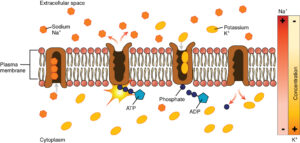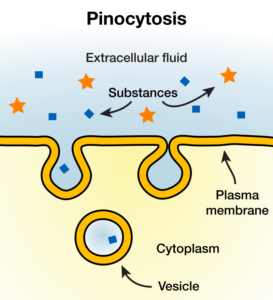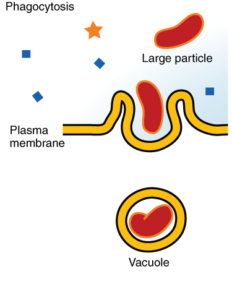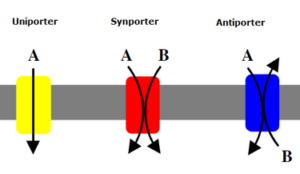In biological terms, active transport indicates the movement of molecules in the opposite direction of the concentration gradient.
In cells, most molecules must travel across a membrane. This very movement of molecules from lower to higher concentration regions by using a transporter or energy is referred to as active transport.
Here we will discuss the following Molecules Active Transport Examples which include:
- Sodium-Potassium Pump
- Calcium pump
- Proton pump
- Sodium-Glucose Transport Protein
- Pinocytosis
- Phagocytosis
- Multidrug ABC transporters
- Sodium-calcium antiporter
Active transport requires the solvent molecules to move across the membrane which is not possible without some help. This help is usually is nothing but utilization of energy in the form of ATP. Even among them, active transport can be of 3 types-primary active transport, secondary active transport and bulk active transport.
SODIUM-POTASSIUM PUMP
Also known as Na+/K+ -ATPase or simple the Na+/K+ pump is actually an enzyme that is the most commonly known example for active transport.

Image: Wikipedia
Animal cells need sodium and potassium gradients across the plasma membrane for a range of purposes, and the variation of demands necessitates that the ion pump in charge, the Na+/K+ -ATPase, be fine-tuned to the many cellular needs.
Function: Functions include working as cell transducers and controlling cell signaling in neurons.
CALCIUM PUMP
Calcium pumps are a kind of ion transporter found in all animal cells’ cellular membranes. They are in charge of maintaining the high Ca2+ electrochemical gradient across the cell membrane by actively transporting calcium out of the cell.
Calcium pumps are essential in cell signaling as they keep intracellular calcium concentrations 10,000 times lower than extracellular calcium concentrations.
Function: When a stimulus signal opens the Ca2+ channels in the membrane, these pumps are required to create the steep electrochemical gradient that permits Ca2+ to flood into the cytosol. Pumps are also required to actively pump Ca2+ out of the cytoplasm and restore the cell’s pre-signal condition.
PROTON PUMP
A proton pump is an integral membrane protein pump that builds up a proton gradient across a biological membrane. Proton pumps catalyze the following reaction:
H+[from one side of a biological membrane] + energy ⇌ H+[to the other side of the membrane]
Function: In the stomach’s parietal cells, the proton pump (H+/K+-ATPase) is the primary mechanism for acid secretion, and inhibiting the pump nearly totally stops acid production.
SODIUM-GLUCOSE TRANSPORT PROTEIN
The activity of the sodium-glucose cotransporter (SGLT) facilitates sodium and glucose transport through cell membranes at the apical level. Active removal of sodium by the sodium/potassium-ATPase present in the basal epithelial cells is what drives cotransport.
This facilitates glucose absorption against an internal uphill (i.e from lower to higher concentration) gradient.
Functions: ATP molecules are used by the protein to send three sodium ions outside into the bloodstream while bringing in two potassium ions. The proximal tubule cell of the nephron develops a sodium ion gradient from the outside to the inside as a result of this process.
PINOCYTOSIS
Pinocytosis is a kind of endocytosis that involves fluids that include a large number of solutes. This mechanism happens in cells lining the small intestine in humans and is largely employed for fat droplet absorption.

Image: Wikipedia
The cell plasma membrane expands and folds around desired extracellular material during endocytosis, generating a pouch that pinches off to create an internalised vesicle.
Function: Pinocytosis is largely utilised to remove extracellular fluids (ECF) like fat droplets and as a monitor for the immune system.
PHAGOCYTOSIS
Phagocytosis is the process by which phagocytes, or living cells, swallow or engulf other cells(both internal and pathogenic) or particles.
Cells like neutrophils, macrophages, monocytes, eosinophils and some more are what are called professional phagocytes.

Image: Wikipedia
Function: In higher animals, phagocytosis is mostly a defensive response to infection and invasive foreign materials.
MULTIDRUG ABC TRANSPORTERS
Also called anti-bacterial ATP-Binding Cassette transporters, antibiotic resistance processes are plagued by multidrug efflux transporters, which provide bacteria with the ability to avoid most existing medicines.
Even though these transporters were first thought of as proton-pumps, another class of multidrug efflux transporters powered by ATP hydrolysis developed in the mid-’90s by evolution or mutation.
This novel family of transporters was part of one of the most diverse protein families, the ABC transporters, which regulate the entry and efflux of a wide range of chemicals.
Function: They allow bacteria to resist existing antibacterial drugs that could kill them.
SODIUM-CALCIUM ANTIPORTER
To simply put antiports are exchangers, so Sodium-Calcium antiporter is also simply put as Na+/Ca2+ exchanger that removes excess calcium from cells.

In the heart Na+/Ca2+ -antiporter moves 3 Na+ across the plasma membrane in exchange for a single Ca2+ moving them in the opposite direction. It is prominently present in the myocardial cells, skeletal cells, neural cells and nephrons.
Function: They are in charge of controlling -neurosecretion, photoreceptor cell activity, and heart muscle relaxation. They are also responsible for maintaining Ca2+ concentrations in the sarcoplasmic reticulum of cardiac cells, Ca2+ concentrations in the endoplasmic reticulum of excitable and non-excitable cells, and low Ca2+ concentrations in the mitochondria.
Even though these transporters are nothing but small protein molecules they are responsible for making sure every organ and tissue works flawlessly. Thereby they make sure all the cell machinations work without any kinks.
As we grow older a lot of these transporters cannot function properly leading to systems imbalances. Hence they are essential to make sure all organisms can function to their full potential.
Also Read:
- Wave interference examples
- Oval shape examples
- Neutral equilibrium examples
- Exothermic reaction examples
- Physical change heat examples
- Interference of sound examples
- Linear motion examples
- Magnetic force examples detailed insights
- Static equilibrium examples
- Axiom examples

I am Trisha Dey, a postgraduate in Bioinformatics. I pursued my graduate degree in Biochemistry. I love reading .I also have a passion for learning new languages.
Let’s connect through linked in: